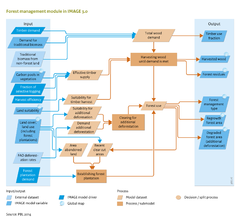Forest management/Data uncertainties limitations: Difference between revisions
Jump to navigation
Jump to search
No edit summary |
Oostenrijr (talk | contribs) No edit summary |
||
| (13 intermediate revisions by 5 users not shown) | |||
| Line 1: | Line 1: | ||
{{ComponentDataUncertaintyAndLimitationsTemplate | {{ComponentDataUncertaintyAndLimitationsTemplate | ||
|Description==== Data === | |Reference=FAO, 2010; IEA, 2012; Brown, 2000; Carle and Holmgren, 2008; UNEP-INTERPOL, 2012; FAO, 2001a; FAO, 2008; | ||
|Description=<h2>Data, uncertainties and limitations</h2> | |||
===Data=== | |||
The main data source for the development and calibration of the forest management module is FAO Forest Resource Assessment ([[FAO, 2010]]), from which data on wood production and deforested areas are derived. In addition, statistics from the International Energy Agency ([[IEA, 2012]]]) are used to estimate the regional fuelwood production, based on household fuelwood and charcoal requirements in national energy statistics. Finally, national data were collected to parameterise the type and production parameters of forest management in world regions (see details in [[Arets et al., 2011]]) and establishment of new forest plantations was designed according to planting rates reported and projected by FAO ([[Brown, 2000]]; [[Carle and Holmgren, 2008]]). | |||
=== Uncertainties === | ===Uncertainties=== | ||
Several assumptions had to be made to project future | Several assumptions had to be made to project future production in forest management systems. These pinpoint the uncertainties in the forestry management model. Better data, monitoring and reporting would improve calibration of the IMAGE forest management module. | ||
FAO Forest Resource Assessment reports are published regularly on quantities of industrially produced wood and the areas of primary and secondary forests. However, these reports do not include the area from which these wood quantities are harvested, and the forest management system of these areas. The amount of wood produced in deforestation processes is not reported, probably due to the illegal nature of many such operations. | |||
Few data are available on the extent of illegal logging, they are not captured in the FAO statistics, but in satellite-based assessments, and only very rough estimates are available ([[UNEP-INTERPOL, 2012]]). In addition, few data are available on informal collection of fuelwood in forests in developing countries ([[FAO, 2001a]]; [[FAO, 2008]]). Estimates of total fuelwood demand are highly uncertain ([[IEA, 2012]]), and fuelwood demand is only partly met by the forestry operations in this IMAGE module. | |||
=== Limitations === | Another uncertainty is the starting point, which is the state of forest use by age cohort in 1970. As forests take several decades to a century to regrow after felling, the effect of historic uncertainties in forest-use extends far into the future. | ||
===Limitations=== | |||
<div class="version changev31"> | |||
Timber demand in IMAGE 3.0 is the total demand of sawlogs, pulpwood (both based on [[FAO]] for the historic period), and fuelwood (based on [[IEA]] and calculated by the [[TIMER model]]). The demand is fulfilled by harvesting wood from any type of forest without specifying the original source of demand. This can be relevant as different types of wood are used for timber, pulp and fuel. For fuelwood we assume that a certain fraction originate from informal sources, like gathering. For specific assessments it would be useful to include this detail in the allocation of forestry. | |||
The timber demand in a region is the sum of local/regional demands and timber claims by other regions. The trade assumptions are adopted from external models, limiting the application of the model for cases with regional timber scarcity. | |||
The only driver of deforestation modelled in IMAGE 3.0 is the net expansion of | |||
agriculture per region. Many drivers of deforestation are not related to agricultural | |||
expansion, but there is no global assessment of these other drivers. Therefore, total | |||
deforestation rates in IMAGE are calibrated to FAO deforestation rates. Drivers and extent of deforestation are very uncertain and subject to debate, yet determine future deforestation and deforestation emissions in scenario simulations. | |||
</div> | |||
}} | }} | ||
Revision as of 14:46, 10 July 2017
Parts of Forest management/Data uncertainties limitations
| Component is implemented in: |
| Components: |
| Related IMAGE components |
| Projects/Applications |
| Key publications |
| References |
